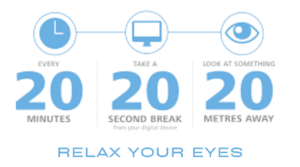Digital Eye Strain
Are your eyes feeling tired, dry, or irritated after long hours in front of a screen? You’re not alone. Digital eye strain, also known as computer vision syndrome, has become a common issue in our tech-driven world. In this article, we’ll explore what causes digital eye strain, its symptoms, and practical tips to protect your eyes in the screen era. Tailored especially for students, office workers, and avid gamers, this guide will help you reduce strain and safeguard your vision.
What Is Digital Eye Strain?
Digital eye strain refers to a group of eye and vision-related problems resulting from prolonged screen use. Whe
ther it’s a computer, smartphone, or tablet, staring at a screen for extended periods can put immense stress on your eyes.
Common Symptoms of Digital Eye Strain
- Blurred vision
- Dry or irritated eyes
- Headaches
- Neck and shoulder pain
- Difficulty focusing on distant objects
What Causes Digital Eye Strain?
Several factors contribute to digital eye strain:
- Prolonged Focus on Screens: Focusing on close-up text or images for hours tires the eye muscles.
- Reduced Blinking: People tend to blink 50% less when using screens, leading to dry eyes.
- Poor Lighting: Glare and improper lighting can strain your eyes further.
- Blue Light Exposure: Screens emit blue light, which can disrupt sleep patterns and contribute to discomfort.
10 Tips to Protect Your Vision
1. Follow the 20-20-20 Rule 
Every 20 minutes, look at something 20 feet away for at least 20 seconds. This
gives your eye muscles a break.
2. Adjust Your Screen Settings
- Increase text size for easy reading.
- Reduce screen brightness to match your surroundings.
- Use dark mode or blue light filters (more on this below).
3. Optimize Your Workspace
- Position your screen at eye level and about 20-28 inches away.
- Ensure your chair and desk setup promote good posture to reduce neck and shoulder strain.
- Keep your screen free of smudges to reduce glare and improve visibility.
4. Blink More Often
Remind yourself to blink consciously to keep your eyes moist.
5. Use Artificial Tears
Over-the-counter eye drops can help alleviate dryness and irritation.
6. Limit Screen Time
Take frequent breaks and consider setting screen time limits, especially for children.
7. Invest in Blue Light Filters
Blue light filters are a game changer for reducing eye strain. You can:
- Use built-in features on your devices, such as Night Shift on iPhones or Night Light on Windows and Android.
- Download apps like flux for additional blue light reduction.
- Consider blue light filtering glasses—an excellent option for students and office workers who spend 8+ hours on screens daily.
8. Adjust Lighting Conditions
Avoid using screens in dark rooms and minimize glare by using anti-glare screen protectors. Use adjustable lighting to reduce contrast between your screen and the room’s brightness.
9. Get Regular Eye Checkups
Visit an eye doctor annually to monitor your vision and address potential issues early.
10. Practice Good Habits Before Bedtime
Avoid screens 1-2 hours before bed to reduce eye strain and improve sleep quality.
Eye Exercises to Reduce Strain
Incorporating eye exercises into your routine can alleviate strain and improve eye health:
1. Palming Technique
Rub your hands together to warm them, then gently place your palms over your closed eyes for 1-2 minutes. This helps relax your eyes and reduce fatigue.
2. Focus Shifting
Hold a pencil or your thumb at arm’s length. Focus on it, then shift your focus to something farther away. Repeat 10 times to strengthen your eye muscles.
3. Eye Rolling
Gently roll your eyes in a circular motion for a few seconds. Repeat in the opposite direction. This can relieve tension and improve flexibility.
4. Figure 8 Exercise
Imagine a giant figure 8 about 10 feet away. Trace it with your eyes slowly, alternating directions for 2 minutes.
Ergonomic Considerations for Screen Use
Creating an ergonomic workspace is essential for reducing digital eye strain, especially for office workers and students:
- Use a chair with proper lumbar support to maintain a healthy posture.
- Adjust your monitor height so the top of the screen is at or slightly below eye level.
- Keep your feet flat on the floor and your knees at a 90-degree angle.
- Use a document holder to avoid constantly shifting focus between printed materials and your screen.
Why Addressing Digital Eye Strain Matters
Ignoring digital eye strain can lead to long-term discomfort and vision problems. By implementing these strategies, you not only protect your eyes but also improve your productivity and overall well-being in the screen era.
Conclusion
Digital eye strain is an inevitable challenge in today’s screen-driven lifestyle, but it doesn’t have to compromise your vision. Tailored advice for students, office workers, and other screen users makes it easier to adopt effective habits. By incorporating small changes like adjusting your workspace, using blue light filters, and practicing eye exercises you can protect your vision and reduce discomfort. Start taking care of your eyes today—your vision is worth it!

